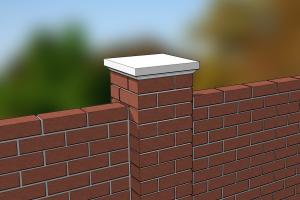Mastering the Craft: A Comprehensive Guide to Building a Brick Wall

-
Quick Links:
- Introduction
- Tools and Materials Needed
- Planning Your Wall
- Preparing the Site
- Laying the Bricks
- Finishing Touches
- Maintenance Tips
- Case Studies and Examples
- Expert Insights
- FAQs
Introduction
Building a brick wall can seem like a daunting task, but with the right guidance and tools, it can turn into a rewarding DIY project. This comprehensive guide will take you through the entire process, from selecting your materials to laying the last brick. Whether you're building a decorative garden wall, a privacy barrier, or a sturdy foundation, understanding the basics of bricklaying will ensure your wall stands the test of time.Tools and Materials Needed
Before diving into the construction process, gather all necessary tools and materials. Here’s a detailed list:Essential Tools
- Brick trowel
- Level
- Measuring tape
- String line
- Hammer
- Chisel
- Jointing tool
- Safety goggles
- Gloves
- Mixing bucket and hoe for mortar
Materials
- Bricks (standard size recommended)
- Masonry mortar
- Weep holes (if necessary for drainage)
Planning Your Wall
Proper planning is crucial to building a durable brick wall. Here are the key aspects to consider:1. Determine the Purpose of Your Wall
- **Privacy:** For creating secluded outdoor spaces. - **Aesthetic:** Enhancing garden or yard appearance. - **Functional:** Retaining soil or providing structural support.2. Measure and Mark the Area
- Use stakes and string to outline the wall’s dimensions. - Ensure the area is level and clear of debris.3. Obtain Necessary Permits
Check local building codes to see if you need a permit for construction.Preparing the Site
Once your plans are set, it’s time to start site preparation.1. Clear the Area
- Remove any grass, rocks, or debris from the construction area. - Excavate if necessary to create a solid foundation.2. Create a Foundation
- Dig a trench that’s at least 6 inches deep and twice the width of your bricks. - Fill the trench with gravel for drainage, and ensure it's compacted.Laying the Bricks
Now comes the fun part: laying the bricks! Follow these steps closely.1. Mix the Mortar
- Follow the manufacturer’s instructions for the correct mortar mix. - Aim for a consistency similar to peanut butter.2. Start Laying the First Course
- Apply a layer of mortar in the trench. - Place the first brick at one end of the wall, pressing it firmly into the mortar.3. Continue Laying Bricks
- Use the level to ensure each brick is even. - Offset the joints by half a brick for stability. - Apply mortar between each brick and on top of the previous course.4. Cut Bricks as Necessary
- Use a chisel and hammer to cut bricks to size for corners or edges.Finishing Touches
Once the wall is built, it's time to add those finishing touches:1. Clean Excess Mortar
- Wipe away any mortar that has oozed out between the bricks before it dries.2. Add Weep Holes (if necessary)
- Drill small holes at the base of the wall for drainage, especially for retaining walls.3. Apply a Sealant
- Consider applying a sealant to protect against water damage.Maintenance Tips
To ensure your brick wall remains in excellent condition, follow these maintenance tips: - Inspect the wall annually for cracks or damage. - Clean the wall with a brush and mild detergent as needed. - Repoint any damaged mortar joints to prevent water intrusion.Case Studies and Examples
Let's delve into some real-world applications of brick walls.1. Residential Privacy Walls
Many homeowners have successfully constructed brick privacy walls. For example, a family in suburban Chicago built a 6-foot privacy wall, which not only enhanced their backyard but also increased property value.2. Garden Retaining Walls
In hilly areas, brick retaining walls are crucial for preventing soil erosion. A landscaping project in California demonstrated the effectiveness of brick in maintaining garden beds.Expert Insights
We consulted with masonry experts to gather valuable insights: - **Training and Practice:** Many experts recommend taking a workshop or class before attempting your first wall. - **Check Weather Conditions:** Ideal bricklaying conditions are dry, mild temperatures. Avoid rainy days to ensure mortar sets properly.FAQs
1. What type of bricks should I use for my wall?
Use standard clay bricks or concrete bricks, depending on your budget and design preferences.
2. How thick should the mortar be between bricks?
A typical mortar joint is about 3/8 inch thick.
3. Can I build a brick wall without a foundation?
No, a solid foundation is essential for stability and longevity.
4. How long does it take to build a brick wall?
Depending on the size and complexity, it can take from a few days to a couple of weeks.
5. Is it necessary to hire a professional?
While DIY is possible, hiring a professional ensures quality and adherence to local codes.
6. How can I prevent my brick wall from cracking?
Ensure proper drainage and maintenance, and choose quality materials.
7. Can I paint my brick wall?
Yes, but use a breathable masonry paint to prevent moisture buildup.
8. What should I do if I find a crack in my wall?
Assess the severity; minor cracks can be filled, while larger ones may require professional repair.
9. How can I increase the aesthetic appeal of my brick wall?
Add climbing plants, lighting, or decorative caps to enhance its appearance.
10. Are there any alternatives to bricks for wall building?
Yes, alternatives include concrete blocks, stone, or wood, each offering different aesthetics and benefits.
Random Reads
- How to choose a good xbox gamertag
- How to check your total call time on an iphone
- How to add use share tickets apple wallet
- What pokemon am i
- View browsing history mac
- How to clean brass
- How to clean bissell carpet cleaner
- How to send whatsapp messages from pc
- Unlocking hidden files searching windows 7
- How to store christmas lights